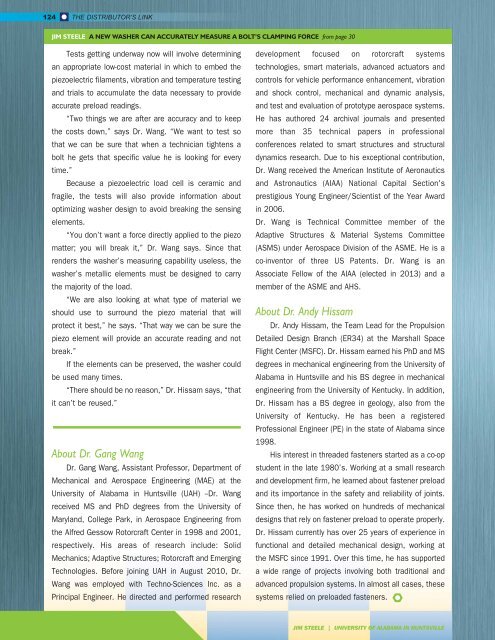WINTER 2016
Distributor's Link Magazine Winter Issue 2016 / Vol 39 No1
Distributor's Link Magazine Winter Issue 2016 / Vol 39 No1
Create successful ePaper yourself
Turn your PDF publications into a flip-book with our unique Google optimized e-Paper software.
124 THE DISTRIBUTOR’S LINK<br />
JIM STEELE ANEWWASHERCANACCURATELYMEASUREABOLT’SCLAMPINGFORCE from page 30<br />
Tests getting underway now will involve determining<br />
an appropriate low-cost material in which to embed the<br />
piezoelectric filaments, vibration and temperature testing<br />
and trials to accumulate the data necessary to provide<br />
accurate preload readings.<br />
“Two things we are after are accuracy and to keep<br />
the costs down,” says Dr. Wang. “We want to test so<br />
that we can be sure that when a technician tightens a<br />
bolt he gets that specific value he is looking for every<br />
time.”<br />
Because a piezoelectric load cell is ceramic and<br />
fragile, the tests will also provide information about<br />
optimizing washer design to avoid breaking the sensing<br />
elements.<br />
“You don’t want a force directly applied to the piezo<br />
matter; you will break it,” Dr. Wang says. Since that<br />
renders the washer’s measuring capability useless, the<br />
washer’s metallic elements must be designed to carry<br />
the majority of the load.<br />
“We are also looking at what type of material we<br />
should use to surround the piezo material that will<br />
protect it best,” he says. “That way we can be sure the<br />
piezo element will provide an accurate reading and not<br />
break.”<br />
If the elements can be preserved, the washer could<br />
be used many times.<br />
“There should be no reason,” Dr. Hissam says, “that<br />
it can’t be reused.”<br />
About Dr. Gang Wang<br />
Dr. Gang Wang, Assistant Professor, Department of<br />
Mechanical and Aerospace Engineering (MAE) at the<br />
University of Alabama in Huntsville (UAH) --Dr. Wang<br />
received MS and PhD degrees from the University of<br />
Maryland, College Park, in Aerospace Engineering from<br />
the Alfred Gessow Rotorcraft Center in 1998 and 2001,<br />
respectively. His areas of research include: Solid<br />
Mechanics; Adaptive Structures; Rotorcraft and Emerging<br />
Technologies. Before joining UAH in August 2010, Dr.<br />
Wang was employed with Techno-Sciences Inc. as a<br />
Principal Engineer. He directed and performed research<br />
development focused on rotorcraft systems<br />
technologies, smart materials, advanced actuators and<br />
controls for vehicle performance enhancement, vibration<br />
and shock control, mechanical and dynamic analysis,<br />
and test and evaluation of prototype aerospace systems.<br />
He has authored 24 archival journals and presented<br />
more than 35 technical papers in professional<br />
conferences related to smart structures and structural<br />
dynamics research. Due to his exceptional contribution,<br />
Dr. Wang received the American Institute of Aeronautics<br />
and Astronautics (AIAA) National Capital Section's<br />
prestigious Young Engineer/Scientist of the Year Award<br />
in 2006.<br />
Dr. Wang is Technical Committee member of the<br />
Adaptive Structures & Material Systems Committee<br />
(ASMS) under Aerospace Division of the ASME. He is a<br />
co-inventor of three US Patents. Dr. Wang is an<br />
Associate Fellow of the AIAA (elected in 2013) and a<br />
member of the ASME and AHS.<br />
About Dr. Andy Hissam<br />
Dr. Andy Hissam, the Team Lead for the Propulsion<br />
Detailed Design Branch (ER34) at the Marshall Space<br />
Flight Center (MSFC). Dr. Hissam earned his PhD and MS<br />
degrees in mechanical engineering from the University of<br />
Alabama in Huntsville and his BS degree in mechanical<br />
engineering from the University of Kentucky. In addition,<br />
Dr. Hissam has a BS degree in geology, also from the<br />
University of Kentucky. He has been a registered<br />
Professional Engineer (PE) in the state of Alabama since<br />
1998.<br />
His interest in threaded fasteners started as a co-op<br />
student in the late 1980’s. Working at a small research<br />
and development firm, he learned about fastener preload<br />
and its importance in the safety and reliability of joints.<br />
Since then, he has worked on hundreds of mechanical<br />
designs that rely on fastener preload to operate properly.<br />
Dr. Hissam currently has over 25 years of experience in<br />
functional and detailed mechanical design, working at<br />
the MSFC since 1991. Over this time, he has supported<br />
a wide range of projects involving both traditional and<br />
advanced propulsion systems. In almost all cases, these<br />
systems relied on preloaded fasteners.<br />
JIM STEELE | UNIVERSITY OF ALABAMA IN HUNTSVILLE

















